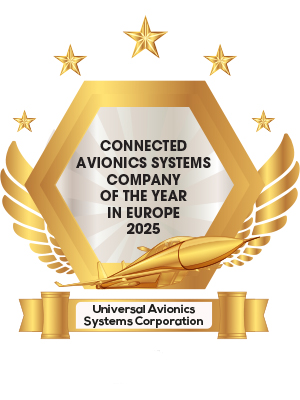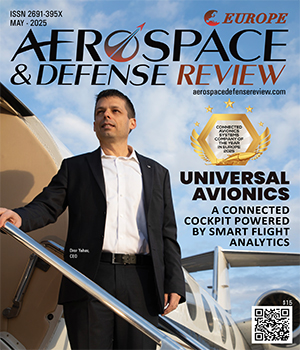THANK YOU FOR SUBSCRIBING
 Dror Yahav, CEO
Dror Yahav, CEOA dongle, no bigger than a thumb drive, plugged into an aircraft’s Solid-State Data Transfer Unit (SSDTU+) has transformed how legacy aircraft interact with modern aviation tools. This compact piece of hardware links older flight management systems (FMS) to the cloud, bridging a technological divide.
The breakthrough emerged from Universal Avionics’ Universal Grand Challenge, an annual competition in which engineers seek to solve aviation’s most pressing problems. The task at hand was to bring legacy aircraft into the digital era without using the costly ‘rip and replace’ approach.
“With a minor hardware modification and a field-installable software upgrade, we’re enabling a secure, certified data interface—seamlessly connecting avionics and the FMS to a pilot’s iPad,” says Dror Yahav, CEO.
Legacy aircraft, built or upgraded with a Universal Avionics FMS, can now integrate with applications in the iPad and benefit from cloud-based solutions. No expensive overhauls. No disruptive downtime. Just a more innovative way to fly.
Getting Updates on the Fly
Pilots have access to a host of benefits as soon as the device is plugged in. An intuitive, easy-to-use graphical interface allows them to interact with the FMS through an electronic flight bag (EFB) installed on an iPad.
 With real-time access to a map integrated with weather and traffic data, situational awareness is enhanced at a glance. The system pulls present position data directly from the FMS and avionics, transforming the iPad into a fully connected flight management tool—leveraging its best-in-class touch capability and display quality.
With real-time access to a map integrated with weather and traffic data, situational awareness is enhanced at a glance. The system pulls present position data directly from the FMS and avionics, transforming the iPad into a fully connected flight management tool—leveraging its best-in-class touch capability and display quality.
Tedious manual maintenance tasks like uploading updated databases into the FMS have also become a thing of the past. Databases are delivered automatically to the iPad from the cloud, available for the specified aircraft FMS. This saves time, reduces the risk of human error and ensures the system remains up-to-date.
A Connected Cockpit Powered by Smart Flight Analytics
Every takeoff and landing manoeuvre generates valuable insights that can optimise engine performance and operational efficiency. This data is lost without a connected avionics system. Universal Avionics is turning raw flight data into actionable intelligence.
Its UA FlightPartner app suite streamlines pilot workflows at every phase of flight. Advanced features include weather-driven Smart Flight Planning, which dynamically adjusts to changing conditions and ADS-B traffic awareness, which provides real-time situational insights. Combined, they enable pilots to make data-driven decisions that enhance safety and efficiency.
The idea is to spend a couple of thousand dollars on an upgrade that can be completed without taking the aircraft out of service. Once you do that, you’ve unlocked a modern connected flight experience, leveraging the iPads that pilots already use
Even after landing, the FlightReview app ensures everything remains up to date. It automates database updates when needed and captures a wide range of flight parameters including precise GNSS data, flown routes and control display unit keypresses to provide detailed insights into performance, safety and training. With cloud-based reporting and analytics integration, pilots and operators can review flight data, track patterns and refine future operations.
An era of a connected cockpit environment means cybersecurity is as critical as flight safety. Every data exchange—from flight plans to performance analytics—must be protected against unauthorised access, system interference and data breaches.
Universal Avionics ensures end-to-end security with a patented authentication process that secures Wi-Fi connections between the SSDTU+ and iPad applications. This encryption process safeguards every data transfer to and from the aircraft’s avionics, preventing cyber threats and protecting sensitive flight information.
The connected avionics solutions are also subjected to rigorous cybersecurity testing, including Federal Aviation Administration (FAA)-approved penetration testing. These measures align with strict compliance frameworks set by the FAA, the Department of Homeland Security and the National Institute of Standards and Technology.
Pilots, fleet managers and operators can fly with confidence, knowing their data and avionics are protected by battle-tested security measures.
-
With a minor hardware modification and a field-installable software upgrade, we’re enabling a secure, certified data interface—seamlessly connecting avionics and the FMS to a pilot’s iPad
Modernise Without Disruption
For airlines, efficiency is essential to avoid costly delays and ensure smooth operations. Yet, for every flight, countless behind-the-scenes tasks—some outdated, some time-consuming—add to operational strain.
 A regional airline operating a fleet of 20 to 30 aircraft faced this challenge. Every 28 days, their technicians were required to spend 30 minutes per aircraft updating avionics databases, pulling them away from more critical tasks. Pilots had to manually enter flight plans into the avionics, an extra step that slowed pre-flight preparations.
A regional airline operating a fleet of 20 to 30 aircraft faced this challenge. Every 28 days, their technicians were required to spend 30 minutes per aircraft updating avionics databases, pulling them away from more critical tasks. Pilots had to manually enter flight plans into the avionics, an extra step that slowed pre-flight preparations.
Regulatory compliance added to the workload. Fuel consumption had to be recorded manually in logs and unusual flight events required documentation from the airline’s safety management system (SMS). It was a system begging for an efficient solution.
Universal Avionics innovated an answer that was both optimal and cost efficient; integrated without an overhaul.
“The idea is to spend a couple of thousand dollars on an upgrade that can be completed without taking the aircraft out of service,” says Yahav. “Once you do that, you’ve unlocked a modern connected flight experience, leveraging the iPads that pilots already use.”
Using the flexibility of its iPad-based system, the company connects directly with the airline’s preferred flight planning application. Pilots can now transfer flight plans directly from their iPads to the avionics—eliminating manual entry and streamlining pre-flight preparations.
Embedded into the iPad interface is fuel consumption tracking. No more paperwork and manual errors—just real-time, accurate data for compliance. For SMS reporting, the system’s built-in data logging automatically flags unusual flight events, ensuring the airline has easy access to the information it needs.
The positive impact is immediate. Database updates are now a background task instead of a drain on resources. Pilots save precious minutes before take-off. Compliance is simple instead of stressful.
The AI Co-Pilot That Never Misses a Detail
Another one of Universal Avionics’ groundbreaking advances is an AI-driven co-pilot that transforms verbal ATC instructions into clear, visual cues on an iPad. Instead of jotting down clearances or navigating dense radio chatter, pilots see instant graphical prompts that reduce cognitive load and ensure critical information is never overlooked. This AI-driven app is just the beginning. Universal Avionics envisions a more intelligent cockpit where AI enhances situational awareness, refines pilot decision-making and improves ATC-pilot communications. It is actively exploring AI and machine learning (ML) capabilities to assist in time-critical scenarios like taxi navigation, flight preparation and in-flight optimisations—areas where small inefficiencies can compound into delays or increased fuel costs.
 This shift from reactive to proactive operations is a defining moment for aviation. AI-driven tools are now refining fuel efficiency strategies, predicting mechanical issues before they disrupt schedules and seamlessly integrating cloud-based analytics into aircraft. Universal Avionics is at the forefront of this evolution, giving legacy fleets the kind of advanced, data-driven capabilities that were once exclusive to next-generation aircraft.
This shift from reactive to proactive operations is a defining moment for aviation. AI-driven tools are now refining fuel efficiency strategies, predicting mechanical issues before they disrupt schedules and seamlessly integrating cloud-based analytics into aircraft. Universal Avionics is at the forefront of this evolution, giving legacy fleets the kind of advanced, data-driven capabilities that were once exclusive to next-generation aircraft.
As aviation regulators prepare for a future where AI plays a greater role in flight operations, Universal Avionics ensures its roadmap aligns with emerging industry frameworks. For instance, the European Union Aviation Safety Agency (EASA) Artificial Roadmap 2.0 outlines a structured approach to AI-driven human augmentation and cognitive assistance in aviation decision-making.
Flying Smarter, Together
Universal Avionics sees innovation as applicable to the newest aircraft rolling off the production line, as well as to the vast fleet of legacy aircraft already in the sky.
Whether it’s pioneering enhanced flight vision systems for new platforms or ingeniously revitalising 20-year-old aircraft with iPad-connected intelligence, Universal Avionics is driven by the belief that innovation should be accessible across the spectrum of aviation.
“Universal Avionics is proving that innovation is all about relentlessly pursuing smarter, more efficient and safer flight for every aircraft, in every era,” concludes Yahav.
| Share this Article: |
Universal Avionics
Company
Universal Avionics
Management
Dror Yahav, CEO
Description
Universal Avionics provides innovative solutions, specialising in cost-effective upgrades for existing aircraft. Its focus is connecting legacy systems to modern technology, empowering pilots with enhanced situational awareness and data-driven insights for safer, more efficient flight.






